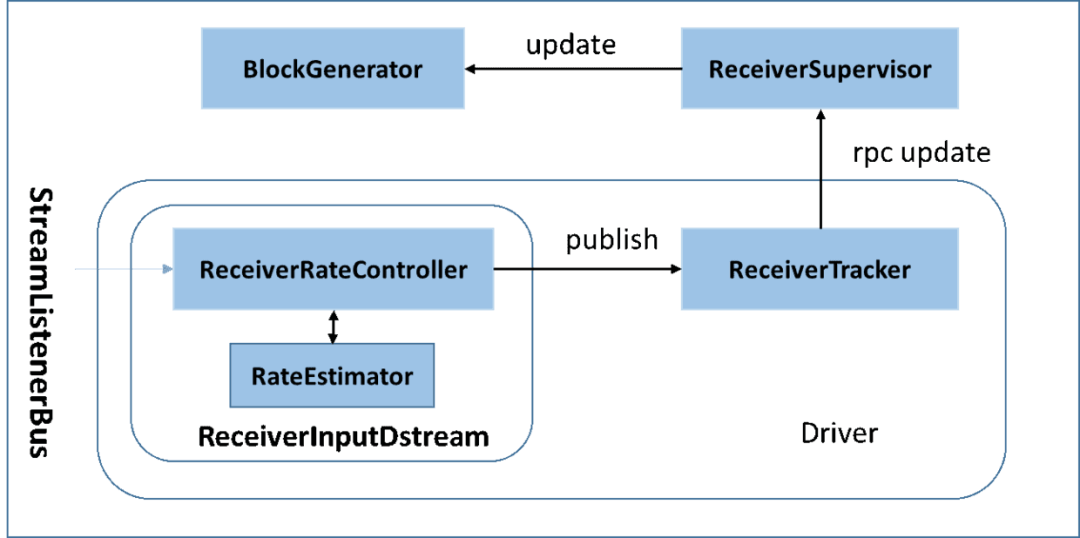Spark Streaming性能优化: 如何在生产环境下动态应对流数据峰值
点击上方蓝色字体,选择“设为星标”

1、为什么引入Backpressure
默认情况下,Spark Streaming通过Receiver以生产者生产数据的速率接收数据,计算过程中会出现batch processing time > batch interval的情况,其中batch processing time 为实际计算一个批次花费时间, batch interval为Streaming应用设置的批处理间隔。这意味着Spark Streaming的数据接收速率高于Spark从队列中移除数据的速率,也就是数据处理能力低,在设置间隔内不能完全处理当前接收速率接收的数据。如果这种情况持续过长的时间,会造成数据在内存中堆积,导致Receiver所在Executor内存溢出等问题(如果设置StorageLevel包含disk, 则内存存放不下的数据会溢写至disk, 加大延迟)。Spark 1.5以前版本,用户如果要限制Receiver的数据接收速率,可以通过设置静态配制参数“spark.streaming.receiver.maxRate ”的值来实现,此举虽然可以通过限制接收速率,来适配当前的处理能力,防止内存溢出,但也会引入其它问题。比如:producer数据生产高于maxRate,当前集群处理能力也高于maxRate,这就会造成资源利用率下降等问题。为了更好的协调数据接收速率与资源处理能力,Spark Streaming 从v1.5开始引入反压机制(back-pressure),通过动态控制数据接收速率来适配集群数据处理能力。
2、Backpressure
Spark Streaming Backpressure: 根据JobScheduler反馈作业的执行信息来动态调整Receiver数据接收率。通过属性“spark.streaming.backpressure.enabled”来控制是否启用backpressure机制,默认值false,即不启用。
附spark2.4.0官网截图:

2.1 Streaming架构如下图所示(详见Streaming数据接收过程文档和Streaming 源码解析)

2.2 BackPressure执行过程如下图所示:
在原架构的基础上加上一个新的组件RateController,这个组件负责监听“OnBatchCompleted”事件,然后从中抽取processingDelay 及schedulingDelay信息. Estimator依据这些信息估算出最大处理速度(rate),最后由基于Receiver的Input Stream将rate通过ReceiverTracker与ReceiverSupervisorImpl转发给BlockGenerator(继承自RateLimiter).

3、BackPressure 源码解析
3.1 RateController类体系
RatenController 继承自StreamingListener. 用于处理BatchCompleted事件。核心代码为:
/**
* A StreamingListener that receives batch completion updates, and maintains
* an estimate of the speed at which this stream should ingest messages,
* given an estimate computation from a `RateEstimator`
*/
private[streaming] abstract class RateController(val streamUID: Int, rateEstimator: RateEstimator)
extends StreamingListener with Serializable {
init()
protected def publish(rate: Long): Unit
@transient
implicit private var executionContext: ExecutionContext = _
@transient
private var rateLimit: AtomicLong = _
/**
* An initialization method called both from the constructor and Serialization code.
*/
private def init() {
executionContext = ExecutionContext.fromExecutorService(
ThreadUtils.newDaemonSingleThreadExecutor("stream-rate-update"))
rateLimit = new AtomicLong(-1L)
}
private def readObject(ois: ObjectInputStream): Unit = Utils.tryOrIOException {
ois.defaultReadObject()
init()
}
/**
* Compute the new rate limit and publish it asynchronously.
*/
private def computeAndPublish(time: Long, elems: Long, workDelay: Long, waitDelay: Long): Unit =
Future[Unit] {
val newRate = rateEstimator.compute(time, elems, workDelay, waitDelay)
newRate.foreach { s =>
rateLimit.set(s.toLong)
publish(getLatestRate())
}
}
def getLatestRate(): Long = rateLimit.get()
override def onBatchCompleted(batchCompleted: StreamingListenerBatchCompleted) {
val elements = batchCompleted.batchInfo.streamIdToInputInfo
for {
processingEnd <- batchCompleted.batchInfo.processingEndTime
workDelay <- batchCompleted.batchInfo.processingDelay
waitDelay <- batchCompleted.batchInfo.schedulingDelay
elems <- elements.get(streamUID).map(_.numRecords)
} computeAndPublish(processingEnd, elems, workDelay, waitDelay)
}
}
3.2 RateController的注册
JobScheduler启动时会抽取在DStreamGraph中注册的所有InputDstream中的rateController,并向ListenerBus注册监听. 此部分代码如下:
def start(): Unit = synchronized {
if (eventLoop != null) return // scheduler has already been started
logDebug("Starting JobScheduler")
eventLoop = new EventLoop[JobSchedulerEvent]("JobScheduler") {
override protected def onReceive(event: JobSchedulerEvent): Unit = processEvent(event)
override protected def onError(e: Throwable): Unit = reportError("Error in job scheduler", e)
}
eventLoop.start()
// attach rate controllers of input streams to receive batch completion updates
for {
inputDStream <- ssc.graph.getInputStreams
rateController <- inputDStream.rateController
} ssc.addStreamingListener(rateController)
listenerBus.start()
receiverTracker = new ReceiverTracker(ssc)
inputInfoTracker = new InputInfoTracker(ssc)
val executorAllocClient: ExecutorAllocationClient = ssc.sparkContext.schedulerBackend match {
case b: ExecutorAllocationClient => b.asInstanceOf[ExecutorAllocationClient]
case _ => null
}
executorAllocationManager = ExecutorAllocationManager.createIfEnabled(
executorAllocClient,
receiverTracker,
ssc.conf,
ssc.graph.batchDuration.milliseconds,
clock)
executorAllocationManager.foreach(ssc.addStreamingListener)
receiverTracker.start()
jobGenerator.start()
executorAllocationManager.foreach(_.start())
logInfo("Started JobScheduler")
}
3.3 BackPressure执行过程分析
BackPressure 执行过程分为BatchCompleted事件触发和事件处理两个过程
3.3.1 BatchCompleted触发过程
对BatchedCompleted的分析,应该从JobGenerator入手,因为BatchedCompleted是批次处理结束的标志,也就是JobGenerator产生的作业执行完成时触发的,因此进行作业执行分析。Streaming 应用中JobGenerator每个Batch Interval都会为应用中的每个Output Stream建立一个Job, 该批次中的所有Job组成一个Job Set.使用JobScheduler的submitJobSet进行批量Job提交。此部分代码结构如下所示:
/** Generate jobs and perform checkpointing for the given `time`. */
private def generateJobs(time: Time) {
// Checkpoint all RDDs marked for checkpointing to ensure their lineages are
// truncated periodically. Otherwise, we may run into stack overflows (SPARK-6847).
ssc.sparkContext.setLocalProperty(RDD.CHECKPOINT_ALL_MARKED_ANCESTORS, "true")
Try {
jobScheduler.receiverTracker.allocateBlocksToBatch(time) // allocate received blocks to batch
graph.generateJobs(time) // generate jobs using allocated block
} match {
case Success(jobs) =>
val streamIdToInputInfos = jobScheduler.inputInfoTracker.getInfo(time)
jobScheduler.submitJobSet(JobSet(time, jobs, streamIdToInputInfos))
case Failure(e) =>
jobScheduler.reportError("Error generating jobs for time " + time, e)
PythonDStream.stopStreamingContextIfPythonProcessIsDead(e)
}
eventLoop.post(DoCheckpoint(time, clearCheckpointDataLater = false))
}
其中,sumitJobSet会创建固定数量的后台线程(具体由“spark.streaming.concurrentJobs”指定),去处理Job Set中的Job. 具体实现逻辑为:
def submitJobSet(jobSet: JobSet) {
if (jobSet.jobs.isEmpty) {
logInfo("No jobs added for time " + jobSet.time)
} else {
listenerBus.post(StreamingListenerBatchSubmitted(jobSet.toBatchInfo))
jobSets.put(jobSet.time, jobSet)
jobSet.jobs.foreach(job => jobExecutor.execute(new JobHandler(job)))
logInfo("Added jobs for time " + jobSet.time)
}
}
其中JobHandler用于执行Job及处理Job执行结果信息。当Job执行完成时会产生JobCompleted事件. JobHandler的具体逻辑如下面代码所示:
private class JobHandler(job: Job) extends Runnable with Logging {
import JobScheduler._
def run() {
val oldProps = ssc.sparkContext.getLocalProperties
try {
ssc.sparkContext.setLocalProperties(SerializationUtils.clone(ssc.savedProperties.get()))
val formattedTime = UIUtils.formatBatchTime(
job.time.milliseconds, ssc.graph.batchDuration.milliseconds, showYYYYMMSS = false)
val batchUrl = s"/streaming/batch/?id=${job.time.milliseconds}"
val batchLinkText = s"[output operation ${job.outputOpId}, batch time ${formattedTime}]"
ssc.sc.setJobDescription(
s"""Streaming job from $batchLinkText""")
ssc.sc.setLocalProperty(BATCH_TIME_PROPERTY_KEY, job.time.milliseconds.toString)
ssc.sc.setLocalProperty(OUTPUT_OP_ID_PROPERTY_KEY, job.outputOpId.toString)
// Checkpoint all RDDs marked for checkpointing to ensure their lineages are
// truncated periodically. Otherwise, we may run into stack overflows (SPARK-6847).
ssc.sparkContext.setLocalProperty(RDD.CHECKPOINT_ALL_MARKED_ANCESTORS, "true")
// We need to assign `eventLoop` to a temp variable. Otherwise, because
// `JobScheduler.stop(false)` may set `eventLoop` to null when this method is running, then
// it's possible that when `post` is called, `eventLoop` happens to null.
var _eventLoop = eventLoop
if (_eventLoop != null) {
_eventLoop.post(JobStarted(job, clock.getTimeMillis()))
// Disable checks for existing output directories in jobs launched by the streaming
// scheduler, since we may need to write output to an existing directory during checkpoint
// recovery; see SPARK-4835 for more details.
SparkHadoopWriterUtils.disableOutputSpecValidation.withValue(true) {
job.run()
}
_eventLoop = eventLoop
if (_eventLoop != null) {
_eventLoop.post(JobCompleted(job, clock.getTimeMillis()))
}
} else {
// JobScheduler has been stopped.
}
} finally {
ssc.sparkContext.setLocalProperties(oldProps)
}
}
}
}
当Job执行完成时,向eventLoop发送JobCompleted事件。EventLoop事件处理器接到JobCompleted事件后将调用handleJobCompletion 来处理Job完成事件。handleJobCompletion使用Job执行信息创建StreamingListenerBatchCompleted事件并通过StreamingListenerBus向监听器发送。实现如下:
private def handleJobCompletion(job: Job, completedTime: Long) {
val jobSet = jobSets.get(job.time)
jobSet.handleJobCompletion(job)
job.setEndTime(completedTime)
listenerBus.post(StreamingListenerOutputOperationCompleted(job.toOutputOperationInfo))
logInfo("Finished job " + job.id + " from job set of time " + jobSet.time)
if (jobSet.hasCompleted) {
listenerBus.post(StreamingListenerBatchCompleted(jobSet.toBatchInfo))
}
job.result match {
case Failure(e) =>
reportError("Error running job " + job, e)
case _ =>
if (jobSet.hasCompleted) {
jobSets.remove(jobSet.time)
jobGenerator.onBatchCompletion(jobSet.time)
logInfo("Total delay: %.3f s for time %s (execution: %.3f s)".format(
jobSet.totalDelay / 1000.0, jobSet.time.toString,
jobSet.processingDelay / 1000.0
))
}
}
}
3.3.2、BatchCompleted事件处理过程
StreamingListenerBus将事件转交给具体的StreamingListener,因此BatchCompleted将交由RateController进行处理。RateController接到BatchCompleted事件后将调用onBatchCompleted对事件进行处理。
override def onBatchCompleted(batchCompleted: StreamingListenerBatchCompleted) {
val elements = batchCompleted.batchInfo.streamIdToInputInfo
for {
processingEnd <- batchCompleted.batchInfo.processingEndTime
workDelay <- batchCompleted.batchInfo.processingDelay
waitDelay <- batchCompleted.batchInfo.schedulingDelay
elems <- elements.get(streamUID).map(_.numRecords)
} computeAndPublish(processingEnd, elems, workDelay, waitDelay)
}
}
onBatchCompleted会从完成的任务中抽取任务的执行延迟和调度延迟,然后用这两个参数用RateEstimator(目前存在唯一实现PIDRateEstimator,proportional-integral-derivative (PID) controller, PID控制器)估算出新的rate并发布。代码如下:
/**
* Compute the new rate limit and publish it asynchronously.
*/
private def computeAndPublish(time: Long, elems: Long, workDelay: Long, waitDelay: Long): Unit =
Future[Unit] {
val newRate = rateEstimator.compute(time, elems, workDelay, waitDelay)
newRate.foreach { s =>
rateLimit.set(s.toLong)
publish(getLatestRate())
}
}
publish的功能为新生成的rate 借助ReceiverTracker进行转发。ReceiverTracker将rate包装成UpdateReceiverRateLimit事交ReceiverTrackerEndpoint:
/** Update a receiver's maximum ingestion rate */
def sendRateUpdate(streamUID: Int, newRate: Long): Unit = synchronized {
if (isTrackerStarted) {
endpoint.send(UpdateReceiverRateLimit(streamUID, newRate))
}
}
ReceiverTrackerEndpoint接到消息后,其将会从receiverTrackingInfos列表中获取Receiver注册时使用的endpoint(实为ReceiverSupervisorImpl),再将rate包装成UpdateLimit发送至endpoint.其接到信息后,使用updateRate更新BlockGenerators(RateLimiter子类),来计算出一个固定的令牌间隔。
其中RateLimiter的updateRate实现如下:
/**
* Set the rate limit to `newRate`. The new rate will not exceed the maximum rate configured by
* {{{spark.streaming.receiver.maxRate}}}, even if `newRate` is higher than that.
*
* @param newRate A new rate in records per second. It has no effect if it's 0 or negative.
*/
private[receiver] def updateRate(newRate: Long): Unit =
if (newRate > 0) {
if (maxRateLimit > 0) {
rateLimiter.setRate(newRate.min(maxRateLimit))
} else {
rateLimiter.setRate(newRate)
}
}
setRate的实现如下:
/**
* Updates the stable rate of this {@code RateLimiter}, that is, the
* {@code permitsPerSecond} argument provided in the factory method that
* constructed the {@code RateLimiter}. Currently throttled threads will not
* be awakened as a result of this invocation, thus they do not observe the new rate;
* only subsequent requests will.
*
* Note though that, since each request repays (by waiting, if necessary) the cost
* of the previous request, this means that the very next request
* after an invocation to {@code setRate} will not be affected by the new rate;
* it will pay the cost of the previous request, which is in terms of the previous rate.
*
*
The behavior of the {@code RateLimiter} is not modified in any other way,
* e.g. if the {@code RateLimiter} was configured with a warmup period of 20 seconds,
* it still has a warmup period of 20 seconds after this method invocation.
*
* @param permitsPerSecond the new stable rate of this {@code RateLimiter}.
*/
public final void setRate(double permitsPerSecond) {
Preconditions.checkArgument(permitsPerSecond > 0.0
&& !Double.isNaN(permitsPerSecond), "rate must be positive");
synchronized (mutex) {
resync(readSafeMicros());
double stableIntervalMicros = TimeUnit.SECONDS.toMicros(1L) / permitsPerSecond;
this.stableIntervalMicros = stableIntervalMicros;
doSetRate(permitsPerSecond, stableIntervalMicros);
}
}
到此,backpressure反压机制调整rate结束。

版权声明:
文章不错?点个【在看】吧! ?




